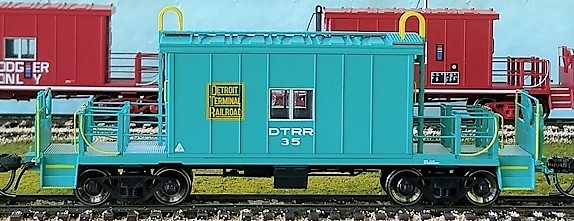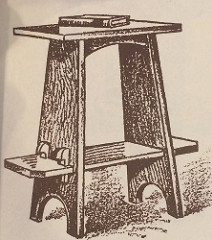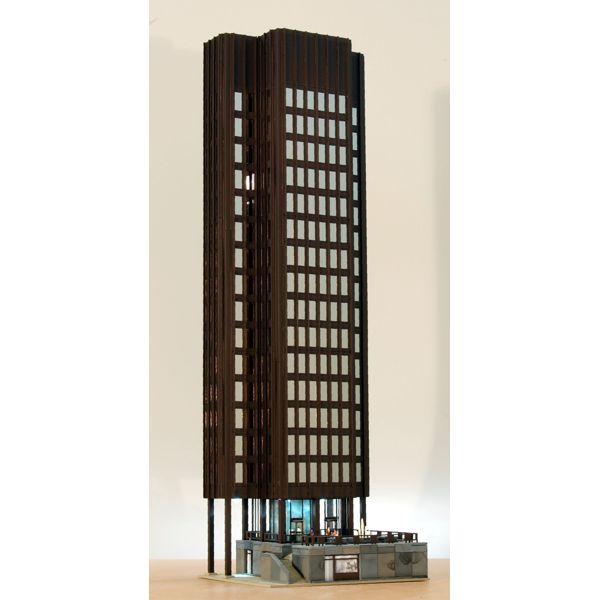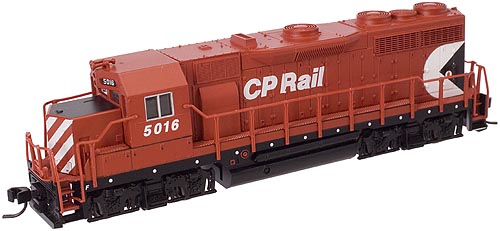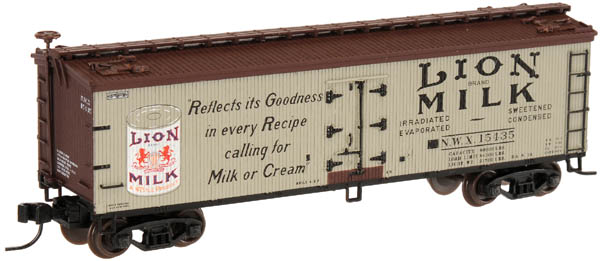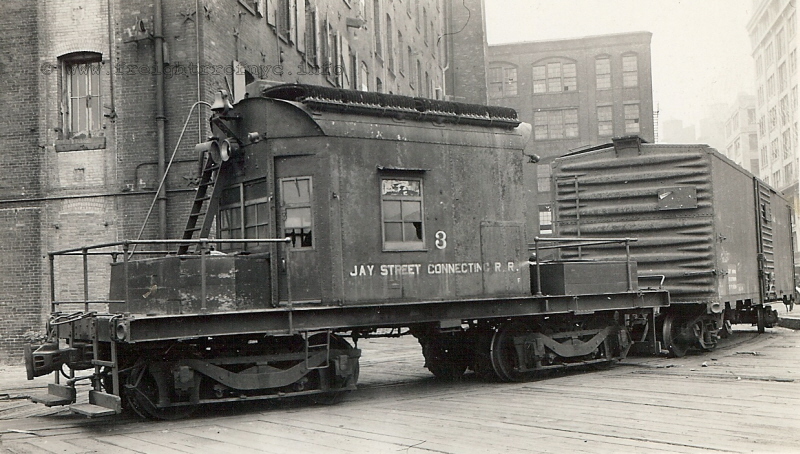Specific Item Information:
Detroit Terminal Railroad also received cabooses from the NYC Despatch Shops in 1967. DTRR was jointly owned at the time by New York Central and Grand Trunk Western. The influence of both parents can be seen in the lettering. Detroit Terminal was merged into Conrail in 1981.
Model Information: This model features: Fox Valley Metal wheels and
Wire grabs and cut levers.
This short body bay window caboose design was developed by International Car and MoPac in the 1970s. Several other railroads used very similar cars. These were assigned to road service and were NOT transfer cabooses.
This short body bay window caboose design was developed by International Car and MoPac in the 1970s. Several other railroads used very similar cars. These were assigned to road service and were NOT transfer cabooses.
Prototype History: A transfer caboose looks more like a flat car with a shed bolted to the middle of it than it does a standard caboose. It is used in transfer service between rail yards or short switching runs, and as such, lacks sleeping, cooking or restroom facilities. The ends of a transfer caboose are left open, with safety railings surrounding the area between the crew compartment and the end of the car.
A recent variation on the transfer caboose is the "pushing" or "shoving" platform. It can be any railcar where a brakeman can safely ride for some distance to help the engineer with visibility at the other end of the train. Flatcars and covered hoppers have been used for this purpose, but often the pushing platform is a caboose that has had its windows covered and welded shut and permanently locked doors. CSX uses former Louisville & Nashville short bay window cabooses and former Conrail waycars as pushing platforms.
From Wikipedia
A recent variation on the transfer caboose is the "pushing" or "shoving" platform. It can be any railcar where a brakeman can safely ride for some distance to help the engineer with visibility at the other end of the train. Flatcars and covered hoppers have been used for this purpose, but often the pushing platform is a caboose that has had its windows covered and welded shut and permanently locked doors. CSX uses former Louisville & Nashville short bay window cabooses and former Conrail waycars as pushing platforms.
From Wikipedia
Road Name History: 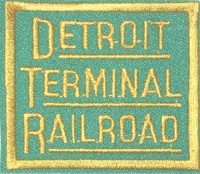 Detroit Terminal Railroad Company was incorporated in the State of Michigan, United States of America, on December 7, 1905 to own railroad track forming a semi-circle around the City of Detroit. It existed as a railroad until it was merged into its parent company, Consolidated Rail Corp., on May 31, 1984.
Detroit Terminal Railroad Company was incorporated in the State of Michigan, United States of America, on December 7, 1905 to own railroad track forming a semi-circle around the City of Detroit. It existed as a railroad until it was merged into its parent company, Consolidated Rail Corp., on May 31, 1984.
By 1905 many of the prime industrial locations in the City of Detroit located on railroad lines were already taken, causing an impediment to the development of the automotive and other industries being created at that time. Detroit Terminal Railroad's trackage extended around the City of Detroit in what is called a "belt line," reaching rural undeveloped locations in order to open up opportunities for new industrial development in the rapidly growing city. Originally planned but never accomplished was a railroad-operated "car ferry" operation to sail the Detroit River to distribute freight at the many docks located along the river that were inaccessible to railway shipping.
Freight movement on the Detroit Terminal Railroad steadily increased up to 1950 fed largely by the development, growth and maturation of the automotive industry in Detroit. Business remained stable throughout the 1950s then slowly started dropping off starting in the 1960s. By 1968 the alarm bells were ringing at Detroit Terminal Railroad's business offices as carloadings had dropped dramatically from a peak of 151,914 in 1953 to 57,543 in 1967. This was a result of changing ways of urban living (natural gas to heat homes instead of railroad-hauled coal) to the closing of major automotive plants in Detroit (DeSoto and Hudson) and also due to the use of large, hi-capacity ("hi-cube" and "autorack") freight cars especially by the automotive companies replacing two or three smaller freight cars needed before. Revenue per freight car moved almost doubled between 1953 and 1967 but operating expenses per freight car moved tripled in this period. Employment drop from 358 in 1953 to 227 in 1967 and salaries took up 98% of operating revenue in 1967. In 1967 there was an estimated $2.5 million in deferred maintenance to tracks and equipment. Blame was placed on poor management of the railroad by its two railroad owners (Michigan Central and Lake Shore & Michigan Southern had merged into the New York Central by this time) who were not paying enough attention to the railroad. Also "deteriorating social conditions" culminating in the 1967 race riots in Detroit at the time were causing an exodus of industries located on the railroad further reducing carloadings.
By the late 1970s on-line business had rapidly declined on the Detroit Terminal Railroad. With railroad consolidation occurring in Detroit as well as nationwide the use of the Detroit Terminal Railroad for the interchange purposes of its two owners had also declined and in 1980 Grand Trunk Western sold its 50% interest in Detroit Terminal Railroad to its other owner, Consolidated Rail Corporation (Conrail). Conrail operated it for a year then, in August 1981, combined Detroit Terminal Railroad operations with its own railroad operations out of its North Yard in Detroit. Over the next couple years Conrail cut back on operating the former Detroit Terminal Railroad trackage and eventually stopped operating over its west end (which, for a while, it accessed from its Livernois Yard at a newly reinstalled connecting track). Today Conrail (Shared Assets) still runs daily trains over what was the east end of the Detroit Terminal Railroad to service a Jeep manufacturing plant owned by Chrysler Group LLC. On May 31, 1984 Conrail legally merged Detroit Terminal Railroad into itself, officially ending 79 years of continuous operation by Detroit's only terminal railroad.

By 1905 many of the prime industrial locations in the City of Detroit located on railroad lines were already taken, causing an impediment to the development of the automotive and other industries being created at that time. Detroit Terminal Railroad's trackage extended around the City of Detroit in what is called a "belt line," reaching rural undeveloped locations in order to open up opportunities for new industrial development in the rapidly growing city. Originally planned but never accomplished was a railroad-operated "car ferry" operation to sail the Detroit River to distribute freight at the many docks located along the river that were inaccessible to railway shipping.
Freight movement on the Detroit Terminal Railroad steadily increased up to 1950 fed largely by the development, growth and maturation of the automotive industry in Detroit. Business remained stable throughout the 1950s then slowly started dropping off starting in the 1960s. By 1968 the alarm bells were ringing at Detroit Terminal Railroad's business offices as carloadings had dropped dramatically from a peak of 151,914 in 1953 to 57,543 in 1967. This was a result of changing ways of urban living (natural gas to heat homes instead of railroad-hauled coal) to the closing of major automotive plants in Detroit (DeSoto and Hudson) and also due to the use of large, hi-capacity ("hi-cube" and "autorack") freight cars especially by the automotive companies replacing two or three smaller freight cars needed before. Revenue per freight car moved almost doubled between 1953 and 1967 but operating expenses per freight car moved tripled in this period. Employment drop from 358 in 1953 to 227 in 1967 and salaries took up 98% of operating revenue in 1967. In 1967 there was an estimated $2.5 million in deferred maintenance to tracks and equipment. Blame was placed on poor management of the railroad by its two railroad owners (Michigan Central and Lake Shore & Michigan Southern had merged into the New York Central by this time) who were not paying enough attention to the railroad. Also "deteriorating social conditions" culminating in the 1967 race riots in Detroit at the time were causing an exodus of industries located on the railroad further reducing carloadings.
By the late 1970s on-line business had rapidly declined on the Detroit Terminal Railroad. With railroad consolidation occurring in Detroit as well as nationwide the use of the Detroit Terminal Railroad for the interchange purposes of its two owners had also declined and in 1980 Grand Trunk Western sold its 50% interest in Detroit Terminal Railroad to its other owner, Consolidated Rail Corporation (Conrail). Conrail operated it for a year then, in August 1981, combined Detroit Terminal Railroad operations with its own railroad operations out of its North Yard in Detroit. Over the next couple years Conrail cut back on operating the former Detroit Terminal Railroad trackage and eventually stopped operating over its west end (which, for a while, it accessed from its Livernois Yard at a newly reinstalled connecting track). Today Conrail (Shared Assets) still runs daily trains over what was the east end of the Detroit Terminal Railroad to service a Jeep manufacturing plant owned by Chrysler Group LLC. On May 31, 1984 Conrail legally merged Detroit Terminal Railroad into itself, officially ending 79 years of continuous operation by Detroit's only terminal railroad.
Brand/Importer Information: Bluford Shops began in 2007 as a side project of two model railroad industry veterans, Craig Ross and Steve Rodgers. They saw a gap between road names available on N scale locomotives but not available on cabooses. They commissioned special runs of Atlas cabooses in Atlantic Coast Line, Central of Georgia, Monon, Boston & Maine and Southern plus runs on Grand Trunk Western and Central Vermont on the MDC wooden cabooses. While these were in process, they began to develop their first all new tooling project, 86' Auto Parts Boxcars in double door and quad door editions in N scale. By January of 2008, Bluford Shops became a full time venture. Along with additional N scale freight cars and their own tooling for new cabooses, they have brought their own caboose line to HO scale. They also have their popular Cornfields in both HO and N. The future looks bright as they continue to develop new products for your railroad.
The town of Bluford in southern Illinois featured a small yard on Illinois Central's Edgewood Cutoff (currently part of CN.) The yard included a roundhouse, concrete coaling tower (which still stands) and large ice house. Reefer trains running between the Gulf Coast and Chicago were re-iced in Bluford. Things are more quiet now in Bluford with the remaining tracks in the yard used to stage hoppers for mines to the south and store covered hoppers. Intersecting the IC line in Bluford is Southern Railway's (currently NS) line between Louisville and St. Louis. Traffic on this single track line remains relatively heavy.
The town of Bluford in southern Illinois featured a small yard on Illinois Central's Edgewood Cutoff (currently part of CN.) The yard included a roundhouse, concrete coaling tower (which still stands) and large ice house. Reefer trains running between the Gulf Coast and Chicago were re-iced in Bluford. Things are more quiet now in Bluford with the remaining tracks in the yard used to stage hoppers for mines to the south and store covered hoppers. Intersecting the IC line in Bluford is Southern Railway's (currently NS) line between Louisville and St. Louis. Traffic on this single track line remains relatively heavy.
Item created by: gdm on 2017-11-22 13:29:48. Last edited by gdm on 2021-03-03 17:04:53
If you see errors or missing data in this entry, please feel free to log in and edit it. Anyone with a Gmail account can log in instantly.
If you see errors or missing data in this entry, please feel free to log in and edit it. Anyone with a Gmail account can log in instantly.


